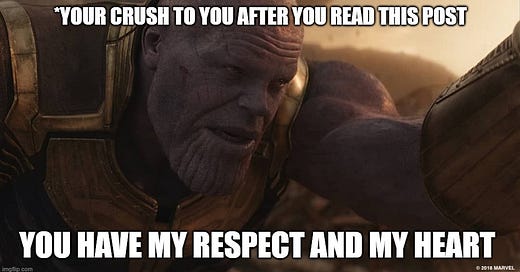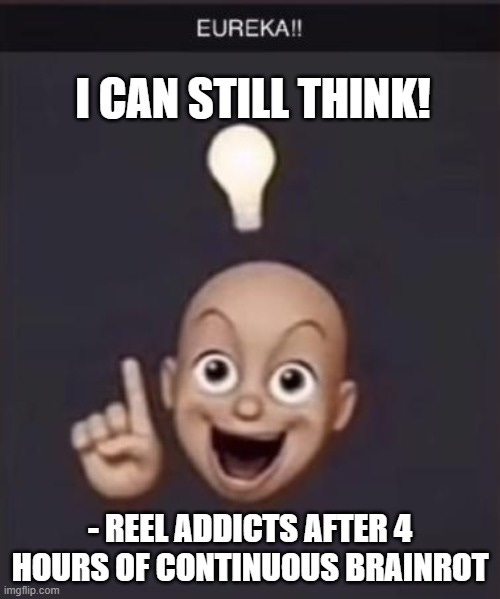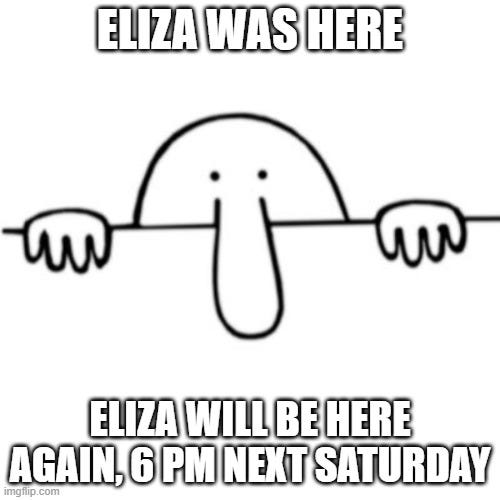Welcome back!
Welcome back to the umm’th (technically 1st but practically 2nd) edition of my newsletter!
I have spent this last week being extremely hazy (and lazy, but shh! I am trying to escape reality so let me -_-).
So as you can see ahem Eliza ahem I have been avoiding my creative emotional writing.
And hence this week I am going to present you the ultimate history of the finest child of internet… Memes! (Can I please call it memology? Pretty please? No? Ok, memology it is!)
This is gonna be long, so brace yourself! (And if you can’t, use the table of contents below kids these days…sigh)
I have covered a lot of stuff from its history, first widespread usage, societal perception of it, some trending memes, when it was first used for protest, its role in today’s protests, yada yada and as many as 5 bonus sections (everything split into 3 parts).
(But you will have to find your crush yourself… even meme won’t find you one so go touch grass, not grease)
For those expecting the classy rickroll for the shumbh aarambh samaroh, aaah you got me.
Take this rickroll link, dance to it and read like you never read your engineering textbook (which is why you are here instead of calling home to your crispy hot gf at home from the Google headquarters at lunch break).
The meaming of memes
Let’s start off by consulting the mighty Oxford itself, the source of all our trauma in English:
an image, a video, a piece of text, etc. that is passed very quickly from one internet user to another, often with slight changes that make it humorous
Example: an internet meme/a blog meme
A second and final definition I will give of meme is from the modern dictionary we all know and absolutely adore, Grammarly:
The modern-day definition of a meme is a humorous image, video, piece of text, or GIF that is spread across the internet, typically on social media, and often with slight variations. Memes can be created by anyone and can be about anything, from current events, to mundane tasks, to pop culture references.
The length of a meme varies. Because they can take the form of images, symbols, text, videos, or GIFs, they can be as short as a single image or phrase and as long as a multi-minute video with an elaborate narrative. Some memes have short-lived bursts of popularity on social media, while others endure for years.
But like the lazy fellows all modern humans are, I am sure most of us didn’t bother to read the above meme definitions. We can only use our hard work for scrolling through meme, after all.
Sigh
Here is a definition of memes specially typed down compiled by yours truly:
Forms of media (it can be an image, video, gif, emoji, symbol, text, etc.) spread from person to person that are humorous in nature and can be used to make new memes with slight modification.
We mostly use the internet for communication today, hence a majority of the population will not identify it as such but memes have actually been around longer than the internet.
History of the term
The term meme was coined by… an evolutionary biologist. Seems like science can invent things other than nuclear weapons.
Anyways, in his 1976 book The Selfish Genes, Richard Dawkins coined the word ‘Meme’, defining it as:
A unit of cultural transmission, or a unit of imitation and replication, analogous to a gene.
As per Dawkins’ argument, just like genes carried biological information crucial to the survival of our species, memes carried forward cultural information including ideas, melodies, fashion, behaviors, styles, phrases and even abstract beliefs that are not crucial to human survival that are spread within a culture either through imitation or learning.
He proposed that these units evolve over time, mutating and undergoing changes over time to dominate themselves as the strongest of their kind. A similar concept was used by Charles Darwin in his now-famous Theory of Natural Selection, and as the Internet proves, memes indeed follow a similar process of evolution in order to adapt and survive against other memes and online phenomena.
Dawkins wanted to create a word that was a monosyllable analogy to the word gene, and came up with memes. This was a term describing how cultural information spread from person to person through different media, like biological information did through memes.
Early use and perception of memes
(Unrelated, but still) Fun Fact!
Dick pic is nothing new- in fact, Romans may not have had internet or emails so they included their dick pics walls, statues, mosaics, necklaces (would you wear a $1 million original Roman dick necklace?) and even wind chimes.
In fact, the first dick pic goes back to over 12000 years ago found… obviously in cave art. We will never know if it was a caveman asking out a cave girl by drawing a picture of his dick in her cave home. We just never will.
Like every sensible invention misused by the masses, meme once used to be a respectable invention by the scientific community. Back then, we didn’t have the internet like we do now (duh) and like our population today, people back then had no interest in reading geeky scientific actually useful books. Which is why the use of this word remained largely limited within academia. Note that even back then meme was expected to alter slightly each time it got passed around, meaning that it helped information apart from the original one spread with its own use.
Before our beloved brainrot social media, we used to have memes in the form of culture passdowns (as per Dawkins himself):
Children’s games and rhymes: I remember playing ‘Aao milo silo saale kaccha dhaga race lagalo’ (what regional version of it did you play?) in my childhood. In fact, like attractiveness became the measure of popularity in high school, these clapping games decided the popularity rankings of girls in junior school. I still remember the awe I felt when the cool kid would invite me to play the clapping game, and not her sidekick. Anyways, the point is these games have defined not just our childhoods, but also cultures as per scientists and cultural anthropologists.
Slangs and catchphrases: Ever since Archimedes shouted ‘Eureka!’ and proceeded to run naked throughout the streets of Syracuse, inventors and discoverers (and memers, we have had a decline in population of the first 2 species) have been Eureka’ing everything they can. There are other catchphrases too, but this one has to be mentioned most importantly because they adapted it wrong today (why are there no videos of the FBI guy who discovered aliens running naked all around the White House?).
Dance move: Think the Charleston or the Twist.
Artistic styles and motifs: Have you come across the skull figure with an hourglass? That’s memento mori- a reminder of your brief, mortal and fragile life the thread of which may be cut at ANY time. Hehe~
Fashion and Trends
Architectural Styles and Building Techniques
Religious Beliefs and Rituals
Eureka meme is a literal meme too.
Kilroy was here!
Starting 1939, World War 2 saw the rise of a drawing of a bald man peeking with a large nose (and sometimes a few hairs) with the text ‘Kilroy was here’. It was quite popular at the time, with soldiers drawing in on battlefields (YES!) and even official places, including the Postdam Conference in 1945 which was attended by Stalin (who reportedly asked his officers who Kilroy was).
Heck Stalin, one story goes that it was a German soldier reported seeing this illustration on an American equipment and reported it to the Führer- yes, Adolf Hitler. Guess what his theory was? It must be a high-level allied spy. Sigh. If only Hitler didn’t give up his smile just because he got rejected from art college.
The origin story for this epic meme that fooled even Hitler is far less remarkable. James Kilroy was an inspector for a shipyard where if riveters erased the inspectors’ mark on the already inspected material, they would be paid double for that week. Kilroy came up with this cartoon to deter these riveting riveters, and the rest is history.
Ok, that’s it for now.
I was thinking of doing this in 2 parts, but 3 will be better, no? Stop squinting at me bro, even if it is memes, history is history and solid research is solid research- both take effort to do.
Stay tuned to know how memes evolved on internet, and why scientists all over the world and obsessively studying it to understand how memes are changing the world (that’s what I was going to write about, originally).
And here is a dank highly meme I made. Please enjoy being offended.
Meanwhile in Taliban, a boy learning English before applying for a fake password for 9/11
Ciao for now!~
Whaaa-
You are saying I duckrolled you earlier?
You want to be rickrolled not duckrolled? You are one persistent hooman. Well, I admire your style.
Take this and get rickrolled in style.
References
As you can see, writing this newsletter is pretty hard work.
Why don’t you show support by sharing my fantastic exploits?
https://www.nytimes.com/2022/01/26/crosswords/what-is-a-meme.html
https://www.nytimes.com/2008/03/24/business/media/24rick.html
https://www.oxfordlearnersdictionaries.com/definition/english/meme
https://www.grammarly.com/blog/language-trends-culture/what-is-a-meme/
https://www.dictionary.com/e/the-original-memes-before-memes-listicle/
Limor Shifman, Memes in a Digital World: Reconciling with a Conceptual Troublemaker, Journal of Computer-Mediated Communication, Volume 18, Issue 3, 1 April 2013, Pages 362–377, https://doi.org/10.1111/jcc4.12013
https://www.pbs.org/independentlens/blog/from-kilroy-to-pepe-a-brief-history-of-memes/
P.S.- I am thinking of creating a gallery for everyone to contribute their most favorite memes where everyone can see it and add even more. What do you think?
Comment here or DM me with ideas! Let’s find who is the most danked (degenerate) memer out of us all!








